Eiffel Tower
| Eiffel Tower | |
|---|---|
| La Tour Eiffel | |
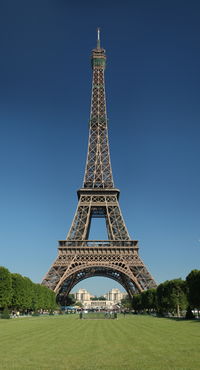 The Eiffel Tower as seen from the Champ de Mars |
|
|
Eiffel Tower was the world's tallest building from 1889 to 1930.[I] |
|
| General information | |
| Location | Paris, France |
| Status | Complete |
| Constructed | 1887–1889 |
| Opening | March 31, 1889 |
| Use | Observation tower, Radio broadcasting tower |
| Height | |
| Antenna or spire | 324.00 m (1,063 ft) |
| Roof | 300.65 m (986 ft) |
| Top floor | 273.00 m (896 ft) |
| Technical details | |
| Floor count | 3 |
| Elevators | 7 |
| Companies involved | |
| Architect(s) | Stephen Sauvestre |
| Structural engineer | Maurice Koechlin, Emile Nouguier |
| Contractor | Gustave Eiffel & Cie |
| Owner | |
| Management | Société d'Exploitation de la Tour Eiffel (SETE) |
| References: [1][2][3][4][5][6][7][8][9] | |
|
^ Fully habitable, self-supported, from main entrance to highest structural or architectural top; see the list of tallest buildings in the world for other listings. |
|
The Eiffel Tower (French: La Tour Eiffel, [tuʁ ɛfɛl], nickname La dame de fer, the iron lady) is an 1889 iron lattice tower located on the Champ de Mars in Paris that has become both a global icon of France and one of the most recognizable structures in the world. The tallest building in Paris,[10] it is the most-visited paid monument in the world; millions of people ascend it every year. Named for its designer, engineer Gustave Eiffel, the tower was built as the entrance arch to the 1889 World's Fair.
The tower stands 324 metres (1,063 ft) tall, about the same height as an 81-storey building. It was the tallest man-made structure in the world from its completion until the Chrysler Building in New York City was built in 1930. Not including broadcast antennas, it is the second-tallest structure in France after the 2004 Millau Viaduct.
The tower has three levels for visitors. Tickets can be purchased to ascend, by stairs or lift, to the first and second levels. The walk to the first level is over 300 steps, as is the walk from the first to the second level. The third and highest level is accessible only by lift. Both the first and second levels feature restaurants.
The tower has become the most prominent symbol of both Paris and France, often in the establishing shot of films set in the city.
Contents |
History
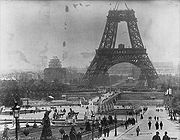
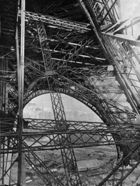
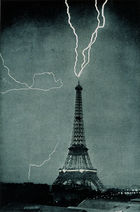
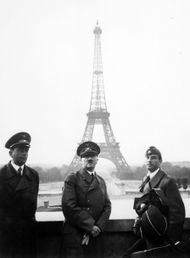
The structure was built between 1887 and 1889 as the entrance arch for the Exposition Universelle, a World's Fair marking the centennial celebration of the French Revolution. Three hundred workers joined together 18,038 pieces of puddled iron (a very pure form of structural iron), using two and a half million rivets, in a structural design by Maurice Koechlin. The co-architects of the Eiffel Tower were Emile Nouguier, Maurice Koechlin and Stephen Sauvestre.[11] The risk of accident was great as, unlike modern skyscrapers, the tower is an open frame without any intermediate floors except the two platforms. However, because Eiffel took safety precautions, including the use of movable stagings, guard-rails and screens, only one man died. The tower was inaugurated on 31 March 1889, and opened on 6 May.
The tower was much criticised by the public when it was built, with many calling it an eyesore. Newspapers of the day were filled with angry letters from the arts community of Paris. One is quoted extensively in William Watson's US Government Printing Office publication of 1892 Paris Universal Exposition: Civil Engineering, Public Works, and Architecture: "And during twenty years we shall see, stretching over the entire city, still thrilling with the genius of so many centuries, we shall see stretching out like a black blot the odious shadow of the odious column built up of riveted iron plates."[12] Signers of this letter included Jean-Louis-Ernest Meissonier, Charles Gounod, Charles Garnier, Jean-Léon Gérôme, William-Adolphe Bouguereau, and Alexandre Dumas.
Novelist Guy de Maupassant—who claimed to hate the tower[13]—supposedly ate lunch in the Tower's restaurant every day. When asked why, he answered that it was the one place in Paris where one could not see the structure. Today, the Tower is widely considered to be a striking piece of structural art.
One of the great Hollywood movie clichés is that the view from a Parisian window always includes the tower. In reality, since zoning restrictions limit the height of most buildings in Paris to 7 stories, only a very few of the taller buildings have a clear view of the tower.
Eiffel had a permit for the tower to stand for 20 years; it was to be dismantled in 1909, when its ownership would revert to the City of Paris. The City had planned to tear it down (part of the original contest rules for designing a tower was that it could be easily demolished) but as the tower proved valuable for communication purposes, it was allowed to remain after the expiry of the permit. The military used it to dispatch Parisian taxis to the front line during the First Battle of the Marne.
Timeline of events
- 10 September 1889
- Thomas Edison visited the tower. He signed the guestbook with the following message—
To M Eiffel the Engineer the brave builder of so gigantic and original specimen of modern Engineering from one who has the greatest respect and admiration for all Engineers including the Great Engineer the Bon Dieu, Thomas Edison.
- 1910
- Father Theodor Wulf measured radiant energy at the top and bottom of the tower, discovering at the top more than was expected, and thereby detecting what are today known as cosmic rays.[14]
- 4 February 1912
- Austrian tailor Franz Reichelt died after jumping 60 metres from the first deck of Eiffel tower with his home-made parachute.
- 1914
- a radio transmitter located in the tower jammed German radio communications during the lead-up to the First Battle of the Marne
- 1925
- The con artist Victor Lustig "sold" the tower for scrap metal on two separate, but related occasions.[15]
- 1930
- The tower lost the title of the world's tallest structure when the Chrysler Building was completed in New York City.
- 1925 to 1934
- Illuminated signs for Citroën adorned three of the tower's four sides, making it the tallest advertising space in the world at the time.
- 1940-1944
- Upon the German occupation of Paris in 1940, the lift cables were cut by the French so that Adolf Hitler would have to climb the steps to the summit. The parts to repair them were allegedly impossible to obtain because of the war. In 1940 German soldiers had to climb to the top to hoist the swastika, but the flag was so large it blew away just a few hours later, and was replaced by a smaller one. When visiting Paris, Hitler chose to stay on the ground. It was said that Hitler conquered France, but did not conquer the Eiffel Tower. A Frenchman scaled the tower during the German occupation to hang the French flag. In August 1944, when the Allies were nearing Paris, Hitler ordered General Dietrich von Choltitz, the military governor of Paris, to demolish the tower along with the rest of the city. Von Choltitz disobeyed the order. The lifts of the Tower were working normally within hours of the Liberation of Paris.
- 3 January 1956
- A fire damaged the top of the tower.
- 1957
- The present radio antenna was added to the top.
- 1980s
- A restaurant and its supporting iron scaffolding midway up the tower was dismantled; it was purchased and reconstructed on St. Charles Avenue and Joesphine Street in Garden District of New Orleans, Louisiana, by entrepreneurs John Onorio and Daniel Bonnot, originally as the Tour Eiffel Restaurant, later as the Red Room and now as the Cricket Club (owned by the New Orleans Culinary Institute). The restaurant was re-assembled from 11,000 pieces that crossed the Atlantic in a 40-foot (12 m) cargo container.
- 31 March 1984
- Robert Moriarty flew a Beechcraft Bonanza through the arches of the tower.[16]
- 1987
- A.J. Hackett made one of his first bungee jumps from the top of the Eiffel Tower, using a special cord he had helped develop. Hackett was arrested by the Paris police upon reaching the ground.[17]
- 27 October 1991
- Thierry Devaux, along with mountain guide Hervé Calvayrac, performed a series of acrobatic figures of bungee jump (not allowed) from the second floor of the Tower. Facing to Champ de Mars, Thierry Devaux was using an electric winch between each figure to go back up. When firemen arrived, he stopped after the sixth bungee jump.[18]
- 14 July 1995
- Bastille Day, French synthesiser musician Jean Michel Jarre performed Concert For Tolerance at the tower in aid of UNESCO. The free concert was attended by an estimated 1.5 million people, filling the Champ de Mars. The concert featured lighting and projection effects on the tower, and a huge fireworks display throughout. Three years later he returned to the same spot for a more dance music-oriented show, Electronic Night.
- New Year's Eve 1999
- The Eiffel Tower played host to Paris' Millennium Celebration. On this occasion, flashing lights and four high-power searchlights were installed on the tower, and fireworks were set off all over it. An exhibition above a cafeteria on the first floor commemorates this event. Since then, the light show has become a nightly event. The searchlights on top of the tower make it a beacon in Paris' night sky, and the 20,000 flash bulbs give the tower a sparkly appearance every hour on the hour.[19]
- 28 November 2002
- The tower received its 200,000,000th guest.[20][21]
- 22 July 2003
- At 19:20, a fire occurred at the top of the tower in the broadcasting equipment room. The entire tower was evacuated; the fire was extinguished after 40 minutes, and there were no reports of injuries.
- 2004
- The Eiffel Tower began hosting an ice skating rink on the first floor each winter.[22]
- 2008
- At the start of the French presidency of the European Union in the second half of 2008, the twelve golden stars of the European flag were mounted on the base, and whole tower bathed in blue light.
Engraved names
Gustave Eiffel engraved on the tower seventy-two names of French scientists, engineers and other notable people. This engraving was painted over at the beginning of the twentieth century but restored in 1986–1987 by the Société Nouvelle d'exploitation de la Tour Eiffel, a company contracted to operate business related to the Tower.
Design of the tower
Material
The metal structure of the Eiffel Tower weighs 7,300 tonnes while the entire structure, including non-metal components, is approximately 10,000 tonnes. As a demonstration of the economy of design, if the 7,300 tonnes of the metal structure were melted down it would fill the 125 metre square base to a depth of only 6 cm (2.36 in), assuming the density of the metal to be 7.8 tonnes per cubic metre. Depending on the ambient temperature, the top of the tower may shift away from the sun by up to 18 cm (7.1 in) because of thermal expansion of the metal on the side facing the sun.
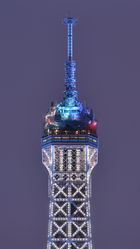
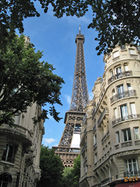
Wind considerations
At the time the tower was built many people were shocked by its daring shape. Eiffel was criticised for the design and accused of trying to create something artistic, or inartistic according to the viewer, without regard to engineering. Eiffel and his engineers, however, as experienced bridge builders, understood the importance of wind forces and knew that if they were going to build the tallest structure in the world they had to be certain it would withstand the wind. In an interview reported in the newspaper Le Temps, Eiffel said:
Now to what phenomenon did I give primary concern in designing the Tower? It was wind resistance. Well then! I hold that the curvature of the monument's four outer edges, which is as mathematical calculation dictated it should be [...] will give a great impression of strength and beauty, for it will reveal to the eyes of the observer the boldness of the design as a whole.[23]
The shape of the tower was determined by empirical methods accounting for the effects of wind, and graphical methods, without an overall mathematical framework. Careful examination of the tower shows a basically exponential shape; actually two different exponentials, the lower section overdesigned to ensure resistance to wind forces.
Several explanations have been proposed over the years; the most recent is a nonlinear integral equation based on counterbalancing the wind pressure on any point on the tower with the tension between the construction elements at that point.[24][25] The tower sways 6–7 cm (2–3 in) in the wind.[26]
Maintenance
Maintenance of the tower includes applying 50 to 60 tonnes of paint every seven years to protect it from rust.
Aesthetic considerations
In order to maintain a uniform appearance to an observer on the ground, three separate colours of paint are used on the tower, with the darkest on the bottom and the lightest at the top. On occasion the colour of the paint is changed; the tower is currently painted a shade of brownish-grey.[27] On the first floor there are interactive consoles hosting a poll for the colour to use for a future session of painting.
The only non-structural elements are the four decorative grillwork arches, added in Stephen Sauvestre's sketches, which served to reassure visitors that the structure was safe, and to frame views of other nearby architecture.[28][29][30]
Tourism
Popularity
More than 200,000,000 people have visited the tower since its construction in 1889,[31] including 6,719,200 in 2006.[26] The tower is the most-visited paid monument in the world.[32][33]
Passenger lifts
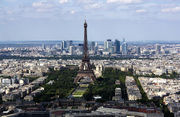
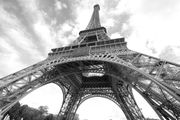
Ground to the second level
The original lifts to the first and second floors were provided by two companies. Both companies had to overcome many technical obstacles as neither company (or indeed any company) had experience with installing lifts climbing to such heights with large loads. The slanting tracks with changing angles further complicated the problems. The East and West lifts were supplied by the French company Roux Combaluzier Lepape, using hydraulically powered chains and rollers. Contemporary engravings of the lift cars show that the passengers were seated at this time but it is not clear whether this was conceptual. It would be unnecessary to seat passengers for a journey of a couple of minutes. The North and South lifts were provided by the American Otis company using car designs similar to the original installation but using an improved hydraulic and cable scheme. The French lifts had a very poor performance and were replaced with the current installations in 1897 (West Pillar) and 1899 (East Pillar) by Fives-Lille using an improved hydraulic and rope scheme. Both of the original installations operated broadly on the principle of the Fives-Lille lifts.[34][35]
The Fives-Lille lifts from ground level to the first and second levels are operated by cables and pulleys driven by massive water-powered pistons. The hydraulic scheme was somewhat unusual for the time in that it included three large counterweights of 200 tonnes each sitting on top of hydraulic rams which doubled up as accumulators for the water. As the lifts ascend the inclined arc of the pillars, the angle of ascent changes. The two lift cabs are kept more or less level and indeed are level at the landings. The cab floors do take on a slight angle at times between landings.
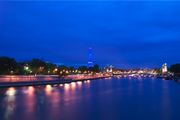
The principle behind the lifts is similar to the operation of a block and tackle but in reverse. Two large hydraulic rams (over 1 metre diameter) with a 16 metre travel are mounted horizontally in the base of the pillar which pushes a carriage (the French word for it translates as chariot and this term will be used henceforth to distinguish it from the lift carriage) with 16 large triple sheaves mounted on it. There are 14 similar sheaves mounted statically. Six wire ropes are rove back and forth between the sheaves such that each rope passes between the 2 sets of sheaves 7 times. The ropes then leave the final sheaves on the chariot and passes up through a series of guiding sheaves to above the second floor and then via a pair of triple sheaves back down to the lift carriage again passing guiding sheaves.
This arrangement means that the lift carriage, complete with its cars and passengers, travels 8 times the distance that the rams move the chariot, the 128 metres from the ground to the second floor. The force exerted by the rams also has to be 8 times the total weight of the lift carriage, cars and passengers, plus extra to account for various losses such as friction. The hydraulic fluid was water, normally stored in three accumulators, complete with counterbalance weights. To make the lift ascend, water was pumped using an electrically driven pump from the accumulators to the two rams. Since the counterbalance weights provided much of the pressure required, the pump only had to provide the extra effort. For the descent, it was only necessary to allow the water to flow back to the accumulators using a control valve. The lifts were operated by an operator perched precariously underneath the lift cars. His position (with a dummy operator) can still be seen on the lifts today.
The Fives-Lille lifts were completely upgraded in 1986 to meet modern safety requirements and to make the lifts easier to operate. A new computer controlled system was installed which completely automated the operation. One of the three counterbalances was taken out of use, and the cars were replaced with a more modern and lighter structure. Most importantly, the main driving force was removed from the original water pump such that the water hydraulic system provided only a counterbalancing function. The main driving force was transferred to a 320 kW electrically driven oil hydraulic pump which drives a pair of hydraulic motors on the chariot itself thus providing the motive power. The new lift cars complete with their carriage and a full 92 passenger load weigh 22 tonnes.
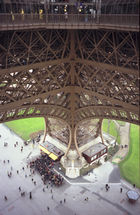
Due to elasticity in the ropes and the time taken to get the cars level with the landings, each lift in normal service takes an average of 8 minutes and 50 seconds to do the round trip spending an average of 1 minute and 15 seconds at each floor. The average journey time between floors is just 1 minute.
The original Otis lifts in the North and South pillars in their turn proved inferior to the new (in 1899) French lifts and were scrapped from the south pillar in 1900 and from the north pillar in 1913 after failed attempts to re-power them with an electric motor. The north and south pillars were to remain without lifts until 1965 when increasing visitor numbers persuaded the operators to install a relatively standard and modern cable hoisted system in the north pillar using a cable-hauled counterbalance weight, but hoisted by a block and tackle system to reduce its travel to one third of the lift travel. The counterbalance is clearly visible within the structure of the North pillar. This latter lift was upgraded in 1995 with new cars and computer controls.
The South pillar acquired a completely new fairly standard electrically driven lift in 1983 to serve the Jules Verne restaurant. This was also supplied by Otis. A further 4 tonne service lift was added to the south pillar in 1989 by Otis to relieve the main lifts when moving relatively small loads or even just maintenance personnel.
The east and west hydraulic (water) lift works are on display and, at least in theory, are open to the public in a small museum located in base of the East and West tower, which is somewhat hidden from public view. Because the massive mechanism requires frequent lubrication and attention, public access is often restricted. However, when open, the wait times are much less than the other, more popular, attractions. The rope mechanism of the North tower is visible to visitors as they exit from the lift.
Second to the third level

The original lift from the second to the third floor were also of a water powered hydraulic design supplied by Léon Edoux. Instead of using a separate counterbalance, the two lift cars counterbalanced each other. A pair of 81 metre long hydraulic rams were mounted on the second level reaching nearly half way up to the third level. A lift car was mounted on top of the rams. Ropes ran from the top of this car up to a sheave on the third level and back down to a second car. The result of this arrangement was that each car only travelled half the distance between the second and third levels and passengers were required to change lifts halfway walking between the cars along a narrow gangway with a very impressive and relatively unobstructed downward view. The 10 tonne cars held 65 passengers each or up to 4 tonnes.
One interesting feature of the original installation was that the hoisting rope ran through guides to retain it on windy days to prevent it flapping and becoming damaged. The guides were mechanically moved out of the way of the ascending car by the movement of the car itself. In spite of some antifreeze being added to the water that operated this system, it nevertheless had to close to the public from November to March each year.


The original lifts complete with their hydraulic mechanism were completely scrapped in 1982 after 97 years of service. They were replaced with two pairs of relatively standard rope hoisted cars which were able to operate all the year round. The cars operate in pairs with one providing the counterbalance for the other. Neither car can move unless both sets of doors are closed and both operators have given a start command. The commands from the cars to the hoisting mechanism are by radio obviating the necessity of a control cable. The replacement installation also has the advantage that the ascent can be made without changing cars and has reduced the ascent time from 8 minutes (including change) to 1 minute and 40 seconds. This installation also has guides for the hoisting ropes but they are electrically operated. The guide once it has moved out of the way as the car ascends automatically reverses when the car has passed to prevent the mechanism becoming snagged on the car on the downward journey in the event it has failed to completely clear the car. Unfortunately these lifts do not have the capacity to move as many people as the 3 public lower lifts and long queues to ascend to the third level are common. Most of the intermediate level structure present on the tower today was installed when the lifts were replaced and allows maintenance workers to take the lift half way.
The replacement of these lifts allowed the restructuring of the criss-cross beams in upper part of the tower and further allowed the installation of two emergency staircases. These replaced the dangerous winding stairs that were installed when the tower was constructed.

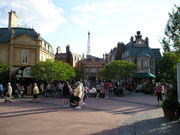
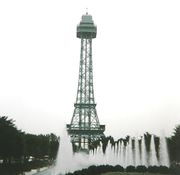
Identical to Kings Dominion near Richmond, Virginia
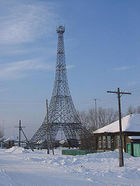
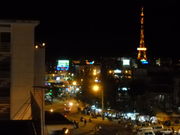
Restaurants
The tower has two restaurants: Altitude 95, on the first floor 311 ft (95 m) above sea level; and the Jules Verne, an expensive gastronomical restaurant on the second floor, with a private lift. This restaurant has one star in the Michelin Red Guide. In January 2007, the multi-Michelin star chef Alain Ducasse was brought in to run Jules Verne.[36]
Attempted Relocation
According to interviews given in the early 1980s Montreal Mayor Jean Drapeau negotiated a secret agreement with French President Charles de Gaulle for the tower to be dismantled and temporarily relocated to Montreal to serve as a landmark and tourist attraction during Expo 67. The plan was allegedly vetoed by the company which operated the tower out of fear that the French government could refuse permission for the tower to be restored to its original location.[37]
Reproductions
As one of the most iconic images in the world, the Eiffel Tower has been the inspiration for the creation of over 30 duplicates and similar towers around the world.
- The Eiffel Tower was the inspiration for the Blackpool Tower in Blackpool, England. After visiting the Great Paris Exhibition in 1889, the town's mayor John Bickerstaffe commissioned the building of the tower, which has a very similar design and was completed 1894. The main differences are that the Blackpool Tower is approximately half the height of the Eiffel Tower and is not freestanding, the base being contained within buildings which house the Tower Circus. Both the Eiffel Tower and Blackpool Tower feature on the list of the World Federation of Great Towers.
Other Eiffel-inspired towers, in order of decreasing height:
- Tokyo Tower in Minato Tokyo, Japan — 332.5 m (1,091 ft)
- In front of the Paris Las Vegas hotel/casino on the Las Vegas Strip, Paradise, Nevada — 165 m (541 ft) (scale 1:2).
- Eiffel Tower of Window of the World, Shenzhen, Guangdong, China — 108 m (354 ft) (scale 1:3)
- Eiffel Tower of Tiandu City Community, Hangzhou, Zhejiang, China — 108 m (354 ft) (scale 1:3)[38][39]
- Kings Island Amusement Park, Mason, Ohio — ~101 m (~332 ft, scale 1:3) [40]
- Kings Dominion Amusement Park, Doswell, Virginia — ~101 m (332 ft, scale 1:3)
- Slobozia, Romania — 54 m (177 ft)
- In Parizh, Chelyabinsk Oblast, Russia. Built by South Ural Cell Telephone company as a cellphone tower — 50 m (164 ft)
- In Zoo, Copenhagen, Denmark. Wooden replica — 50 m (164 ft)
- Watkin's Tower in London, England, UK — Original planned to be 358 m (1,175 ft) high and construction began in 1891, but finally constructed to 47 m (154 ft) and demolished in 1907.
- Fayetteville, North Carolina — The Bordeaux Tower is about 45 m (148 ft) (150 ft)
- Walt Disney World's EPCOT theme park in Lake Buena Vista, Florida (at the France Pavilion in World Showcase) — 23 m (76 ft, scale 1:10)[41]
- Paris, Texas — 20 m (66 ft)
- Eiffel Tower (Paris, Tennessee) in Paris, Tennessee — about 60 feet (18 m) tall.
- As a Meccano model, housed at the SciTrek technology museum in (Atlanta, Georgia) — 11 m (36 ft)[42]
- On the roof of the catering company Rungis Express in Meckenheim and Satteldorf, Germany — (height unknown)
- Centerpiece of the Falconcity of Wonders — a planned new development project in Dubai. UAE, featuring seven modern wonders of the world (planned).[43] (approximate coordinates)
- Inwald Miniature Park, Inwald, Poland
- Mini-Europe, Brussels, a 12.96 m model (a proportion of 1:25 to the original).
- Model on the roof of the Rue De Paris cafe in Brisbane, Australia — (roughly 12 m (39 ft) tall)
- Montmartre, Saskatchewan - 8.5 metres tall.
- Model in the First World Plaza shopping mall in Genting Highlands, Malaysia[44]
- In Austin, Texas there is a 7.5 m (25 ft) tall replica at the Dreyfus Antique Shop.
- An 18 m model in Filiatra, Messinia, Greece, at the entrance of the village[45][46]
- Paris, Michigan; approximately 3 m (10 ft) (10 ft) tall and in a park
- Baku, Azerbaijan, Sahil Trade Center, at "Parfums de France" shop. Approximately 3 m (10 ft) tall.
- Golden Sands sea resort in Varna, Bulgaria — A tower with a ratio of 1:10 to the original is built in the town as a tourist attraction.
- Aktau, Kazakhstan — model at the front of the office of Oil Construction Company
- Satteldorf near Crailsheim, Germany. On the top of a company building
- In 2007 the Lego company released a 1:300 scale model of the Eiffel tower as a set.[47] It contains 3428 pieces and stands 108 cm (42.5 in) tall and 50 cm (19.7 in) wide and deep.
- Da Lat, Vietnam. Design to used as Viettel telecommunications tower
Communications
Since the beginning of the 20th century, the tower has been used for radio transmission. Until the 1950s, an occasionally modified set of antenna wires ran from the summit to anchors on the Avenue de Suffren and Champ de Mars. They were connected to long-wave transmitters in small bunkers; in 1909, a permanent underground radio centre was built near the south pillar and still exists today. On 20 November 1913, the Paris Observatory, using the Eiffel Tower as an antenna, exchanged sustained wireless signals with the United States Naval Observatory which used an antenna in Arlington, Virginia. The object of the transmissions was to measure the difference in longitude between Paris and Washington, D.C.[48] Today, both radio and television stations broadcast their signals from the top of the Eiffel.
FM-radio
| Programme | Frequency | ERP |
|---|---|---|
| France Inter | 87.8 MHz | 10 kW |
| RFI Paris | 89.0 MHz | 10 kW |
| TSF Jazz | 89.9 MHz | 6 kW |
| Nostalgie | 90.4 MHz | 10 kW |
| Chante France | 90.9 MHz | 4 kW |
Television
| Programme | Channel-Number | Frequency | ERP |
|---|---|---|---|
| Canal+ | 6 | 182,25 MHz | 100 kW |
| France 2 | 22 | 479,25 MHz | 500 kW |
| TF1 | 25 | 503,25 MHz | 500 kW |
| France 3 | 28 | 527,25 MHz | 500 kW |
| France 5 | 30 | 543,25 MHz | 100 kW |
| M6 | 33 | 567,25 MHz | 100 kW |
Image copyright claims
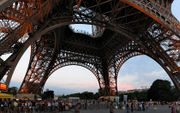
The tower and its representations have long been in the public domain; however, a French court ruled, in March 1992, that the night-time light display is protected under copyright, except in a panoramic view. SNTE (Société nouvelle d'exploitation de la tour Eiffel) installed a special lighting display on the tower in 1989, for the tower's 100th anniversary. The Court of Cassation, France's judicial court of last resort, decided that the display was an "original visual creation" protected by copyright.[49] Since then, the SNTE considers any night-time image of the lighting display under copyright. As a result, it is no longer legal to publish contemporary photographs of the tower at night without permission in France and some other countries.[50][51]
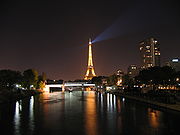
The imposition of copyright has been controversial. The Director of Documentation for SNTE, Stéphane Dieu, commented in January 2005, "It is really just a way to manage commercial use of the image, so that it isn't used in ways we don't approve." However, it also potentially has the effect of prohibiting tourist photographs of the tower at night from being published,[52] as well as hindering non-profit and semi-commercial publication of images of the tower. Besides, French doctrine and jurisprudence traditionally allow pictures incorporating a copyrighted work as long as their presence is incidental or accessory to the main represented subject,[53] a reasoning akin to the De minimis rule. Thus, SNTE could not claim copyright on photographs of panoramas of Paris incorporating the lit tower.
In popular culture
As a global landmark, the Eiffel Tower is featured in media including films, video games, and television shows.
In a commitment ceremony in 2007, Erika Eiffel, an American woman famously "married" the Eiffel Tower. Her relationship with the tower has been the subject of extensive global publicity.[54]
Taller structures
Although it was the world's tallest structure when completed in 1889, the Eiffel Tower has since lost its standing both as the tallest lattice tower and as the tallest structure in France.
Lattice towers taller than the Eiffel Tower
| Name | Pinnacle height | Year | Country | Town | Remarks |
|---|---|---|---|---|---|
| Kiev TV Tower | 1,263 ft (385 m) | 1973 | Ukraine | Kiev | Tallest lattice tower of the world |
| Tashkent Tower | 1,230 ft (375 m) | 1985 | Uzbekistan | Tashkent | |
| Pylons of Yangtze River Crossing | 1,137 ft (347 m) | 2003 | People's Republic of China | Jiangyin | 2 towers, tallest pylons in the world |
| Dragon Tower | 1,102 ft (336 m) | 2000 | People's Republic of China | Harbin | |
| Tokyo Tower | 1,091 ft (333 m) | 1958 | Japan | Tokyo | |
| WITI TV Tower | 1,078 ft (329 m) | 1962 | U.S. | Shorewood, Wisconsin | |
| WSB TV Tower | 1,075 ft (328 m) | 1957 | U.S. | Atlanta, Georgia |
Architectural structures in France taller than the Eiffel Tower
| Name | Pinnacle height | Year | Structure type | Town | Remarks |
|---|---|---|---|---|---|
| Longwave transmitter Allouis | 350 m | 1974 | Guyed Mast | Allouis | |
| HWU transmitter | 350 m | ? | Guyed Mast | Rosnay | Multiple masts |
| Viaduc de Millau | 343 m | 2004 | Bridge Pillar | Millau | |
| TV Mast Niort-Maisonnay | 330 m | ? | Guyed Mast | Niort | |
| Transmitter Le Mans-Mayet | 342 m | 1993 | Guyed Mast | Mayet | |
| Transmitter Roumoules | 330 m | 1974 | Guyed Mast | Roumoules | spare transmission mast for long wave, insulated against ground |
Other structures carrying this name
- Eiffel Tower (Paris, Tennessee)
- Eiffel Tower Co-op in Hackensack, New Jersey, USA[55]
Gallery
 Taken from the top of L'Arc de Triomphe on a cloudy Spring day. |
 From the highest platform. |
 The Eiffel Tower from below. |
 Eiffel Tower while France was bidding for the 2012 Olympic Games, summer 2005 |
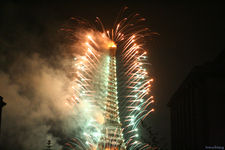 Eiffel tower on Bastille Day |
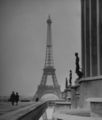 The Eiffel Tower taken shortly after the end of World War II, in June of 1945 |
 The Eiffel Tower at sunrise from the Trocadero |
 The Eiffel Tower as seen from Rue de Monttessuy in the 7th arrondissement. |
 Eiffel Tower Lift Hydraulics |
 Controls from one of the Eiffel Tower lifts |
 Some of the automation controls at the base of one of the Eiffel Tower's lifts. |
 Interior of the Altitude 95 restaurant in the Eiffel Tower. |
See also
- List of tallest buildings and structures in the Paris region
- List of tallest buildings and structures in the world
- List of tallest freestanding structures in the world
- List of tallest towers in the world
References
- ↑ "Identity card of the Eiffel Tower" (in (English)). Tour-eiffel.fr. 2009-12-31. http://www.tour-eiffel.fr/teiffel/uk/documentation/chiffres/page/identite.html?id=4_14. Retrieved 2010-05-24.
- ↑ "The documents" (in (English)). Tour-eiffel.fr. http://www.tour-eiffel.fr/teiffel/uk/documentation/dossiers/index.html?id=4_12. Retrieved 2010-05-24.
- ↑ "The structure of the Eiffel Tower and its evolution" (in (English)). Tour-eiffel.fr. http://www.tour-eiffel.fr/teiffel/uk/documentation/structure/page/structure.html?id=4_13. Retrieved 2010-05-24.
- ↑ "Chronology of the main construction periods" (in (English)). Tour-eiffel.fr. http://www.tour-eiffel.fr/teiffel/uk/documentation/structure/page/chronologie.html. Retrieved 2010-05-24.
- ↑ "A few statistics" (in (English)). Tour-eiffel.fr. http://www.tour-eiffel.fr/teiffel/uk/documentation/structure/page/chiffres.html. Retrieved 2010-05-24.
- ↑ "Dictionary of technical terms" (in (English)). Tour-eiffel.fr. http://www.tour-eiffel.fr/teiffel/uk/documentation/structure/page/lexique.html. Retrieved 2010-05-24.
- ↑ (English) http://www.tour-eiffel.fr/teiffel/uk/documentation/pdf/about_the%20Eiffel_Tower.pdf?id=4_11
- ↑ "The Tower operating company" (in (English)). Tour-eiffel.fr. http://www.tour-eiffel.fr/teiffel/uk/documentation/chiffres/page/entreprise.html. Retrieved 2010-05-24.
- ↑ "The industrial maintenance of the Tower" (in (English)). Tour-eiffel.fr. http://www.tour-eiffel.fr/teiffel/uk/documentation/chiffres/page/usine.html. Retrieved 2010-05-24.
- ↑ "The Eiffel Tower as a World monument" (in (English)). Tour-eiffel.fr. 1996-04-02. http://www.tour-eiffel.fr/teiffel/uk/documentation/chiffres/page/tour_monde.html. Retrieved 2010-05-24.
- ↑ "The Tower Conception And Design" (in (English)). Tour-eiffel.fr. http://www.tour-eiffel.fr/teiffel/uk/documentation/dossiers/page/invention.html. Retrieved 2010-05-24.
- ↑ Watson, William. Paris Universal Exposition: Civil Engineering, Public Works, and Architecture (Washington: Government Printing office, 1892), 833.
- ↑ Jonnes, Jill (2009). Eiffel's Tower: And the World's Fair Where Buffalo Bill Beguiled Paris, the Artists Quarreled, and Thomas Edison Became a Count. Viking Adult. pp. 163–64. ISBN 978-0670020607.
- ↑ Wulf, Theodor. Physikalische Zeitschrift, contains results of the four-day long observation done by Theodor Wulf while at the top of the Eiffel Tower in 1910.
- ↑ Letcher, Piers (2003). Eccentric France. Bradt Travel Guides. p. 105. ISBN 978-1841620688.
- ↑ "A Bonanza in Paris". http://proairshow.com/Eiffel.htm. Retrieved 2008-04-04.
- ↑ "Extreme bid to stretch bungy record - World". smh.com.au. 2007-02-27. http://www.smh.com.au/news/world/extreme-bid-to-stretch-bungy-record/2007/02/27/1172338606150.html. Retrieved 2010-05-24.
- ↑ [http:// http://www.sunnydream.info/index.php?page=eiffel "Eiffel Tower"]. 1991-10-21. http:// http://www.sunnydream.info/index.php?page=eiffel. Retrieved 2010-06-24.
- ↑ "All You Need To Know About the Eiffel Tower". Official Site. http://www.tour-eiffel.fr/teiffel/uk/documentation/pdf/about_the%20Eiffel_Tower.pdf?id=4_11. Retrieved 2009-01-09.
- ↑ "The Eiffel Tower: Paris' Grande Dame". france.com. http://www.france.com/docs/97.html. Retrieved 2007-07-24.
- ↑ "Soirée réussie le 28 novembre pour fêter l'année du 200 millionième visiteur" (in French). Official Site. 2002. http://www.tour-eiffel.fr/teiffel/fr/actualites/page/news_list.html?Year=2002#News122. Retrieved 2007-07-24.
- ↑ Porter, Darwin; Prince, D; McDonald, G; Mastrini, H; Marker, S; Princz, A; Bánfalvy, C; Kutor, A; Lakos, N (2006). Frommer's Europe. 9th ed.. Frommer's. p. 318. ISBN 978-0471922650.
- ↑ Translated from the French newspaper Le Temps of 14 February 1887. Extrait de la réponse d'Eiffel
- ↑ "Elegant Shape Of Eiffel Tower Solved Mathematically By University Of Colorado Professor". Sciencedaily.com. 2005-01-07. http://www.sciencedaily.com/releases/2005/01/050106111209.htm. Retrieved 2010-05-24.
- ↑ "The Virginia Engineer: Correct Theory Explaining The Eiffel Tower's Design Revealed". Vaeng.com. 2005-01-31. http://www.vaeng.com/news/correct-theory-explaining-the-eiffel-towers-design-revealed. Retrieved 2010-05-24.
- ↑ 26.0 26.1 "A few statistics" (in (French)). Tour-eiffel.fr. http://www.tour-eiffel.fr/teiffel/uk/documentation/structure/page/chiffres.html. Retrieved 2010-05-24.
- ↑ "Painting the Eiffel Tower" (in (French)). Tour-eiffel.fr. http://www.tour-eiffel.fr/teiffel/uk/documentation/dossiers/page/peinture.html. Retrieved 2010-05-24.
- ↑ "Corus in construction - Exhibition buildings". Corusconstruction.com. http://www.corusconstruction.com/en/reference/teaching_resources/architectural_studio_reference/history/development_of_the_clear_span_building/exhibition_buildings/. Retrieved 2010-05-24.
- ↑ "The annotated arch: a crash course in the history of architecture, By Carol Strickland, Amy Handy - Google Books". Google.com. http://www.google.com/books?id=rdiFhC6XOWwC&printsec=frontcover&source=gbs_navlinks_s#v=onepage&q=&f=false. Retrieved 2010-05-24.
- ↑ "Space, time and architecture: the growth of a new tradition, By Sigfried Giedion - Google Books". Google.com. http://www.google.com/books?id=ZHZnmKxkGMwC&printsec=frontcover&source=gbs_navlinks_s#v=onepage&q=&f=false. Retrieved 2010-05-24.
- ↑ "Number of visitors since 1889" (in (French)). Tour-eiffel.fr. http://www.tour-eiffel.fr/teiffel/uk/documentation/chiffres/page/frequentation.html. Retrieved 2010-05-24.
- ↑ The Guardian: New look for Eiffel Tower
- ↑ "Tour Eiffel et souvenirs de Paris". LeMonde.fr. http://www.lemonde.fr/web/article/0,1-0@2-3232,36-938349,0.html. Retrieved 2010-05-24.
- ↑ "The construction of the Eiffel Tower" (in (French)). Tour-eiffel.fr. http://www.tour-eiffel.fr/teiffel/uk/documentation/dossiers/page/construction.html. Retrieved 2010-05-24.
- ↑ Société nouvelle d'exploitation de la tour Eiffel
- ↑ Fawcett, Karen. "Paris France Guide: Paris Hotels, Food, Wine and Discounts - The Eiffel Tower Breaking News". Bonjourparis.com. http://www.bonjourparis.com/Articles/Destination_Paris/The_Eiffel_Tower__Breaking_News/. Retrieved 2010-05-24.
- ↑ "Mayor Jean Drapeau aims for an Expo 67 tower - CBC Archives". Archives.cbc.ca. 2009-08-14. http://archives.cbc.ca/society/celebrations/clips/554/. Retrieved 2010-05-24.
- ↑ "Reuters.com". Reuters.com. 2009-02-09. http://www.reuters.com/news/pictures/slideshow?collectionId=969. Retrieved 2010-05-24.
- ↑ lefigaro.fr. "Le Figaro – Actualité en direct et informations en continu". Lefigaro.fr. http://www.lefigaro.fr/economie/20070823.FIG000000095__hangzhou_les_chinois_batissent_une_replique_de_paris.html. Retrieved 2010-05-24.
- ↑ "KI Mobile". Visitkingsisland.com. http://www.visitkingsisland.com/attractions/detail.cfm?ai_id=153. Retrieved 2010-05-24.
- ↑ Disney's official French Pavilion page — lists the Eiffel Tower as approximately 1/10th the height of the original.
- ↑ "Eiffel Tower". Dalefield.com. http://www.dalefield.com/mwes/history/eiffel_tower.html. Retrieved 2010-05-24.
- ↑ ":: Falconcity of Wonders (L.L.C) ::". Falconcity.com. http://www.falconcity.com/. Retrieved 2010-05-24.
- ↑ First World Plaza. Retrieved on 2008-09-13
- ↑ "Tower model at Filiatra". Users.mes.sch.gr. 2001-03-22. http://users.mes.sch.gr/stamgian/ERG_MATINAS.htm. Retrieved 2010-05-24.
- ↑ Photograph of Filiatra tower
- ↑ "LUGNET Set Guide". Guide.lugnet.com. http://guide.lugnet.com/set/10181. Retrieved 2010-05-24.
- ↑ "Paris Time By Wireless", New York Times, 22 November 1913, pg 1.
- ↑ Cass. 1re civ., 3 March 1992, RIDA 1994 no. 159, p.113.
- ↑ "Statement that publishing pictures of the lighting requires a fee" (in (French)). Tour-eiffel.fr. http://www.tour-eiffel.fr/teiffel/uk/pratique/faq/index.html?id=2_10. Retrieved 2010-05-24.
- ↑ In the United States, for example, 17 U.S.C. § 120(a) explicitly permits the publication of photographs of copyrighted architecture in public spaces. In Germany this is known as Panoramafreiheit.
- ↑ "Eiffel Tower: Repossessed". Blog.fastcompany.com. 2005-02-02. http://blog.fastcompany.com/archives/2005/02/02/eiffel_tower_repossessed.html. Retrieved 2010-05-24.
- ↑ E.g., "La représentation d'une œuvre située dans un lieu public n'est licite que lorsqu'elle est accessoire par rapport au sujet principal représenté ou traité"; Cass. 1re civ. 4 juillet 1995. Christophe Caron, Droit d'auteur et droits voisins, Litec, 2006, §365.
- ↑ "Inanimate attachment: Love objects". The Globe and Mail. August 21, 2009. http://www.theglobeandmail.com/life/family-and-relationships/love-objects/article1259075/. Retrieved 2010-05-04.
- ↑ "Eiffel Tower Co-op —". Skyscraperpage.com. http://skyscraperpage.com/cities/?buildingID=19207. Retrieved 2010-05-24.
Further reading
- 1889 La Tour Eiffel et L’Exposition Universelle, Musée d'Orsay, 16 May – 15 August 1989 [exhibition catalog]. Paris: Editions de la Reunion des Musees Nationaux, 1989
- Frémy, Dominique, Quid de la Tour Eiffel, Robert Lafont, Paris (1989) — out of print
- Engineering. The Paris Exhibition, 3 May 1889 (Vol. XLVII). London: Office for Advertisements and Publication.
- Eiffel's Tower by Jill Jonnes (Viking 2009)
- Watson, William. Paris Universal Exposition: Civil Engineering, Public Works, and Architecture. Washington [DC], Government Printing Office, 1892.
- Chanson, Hubert (2009). Hydraulic Engineering Legends Listed on the Eiffel Tower, in "Great Rivers History", ASCE-EWRI Publication, Proceedings of the History Symposium of the World Environmental and Water Resources Congress 2009, Kansas City, USA, 17–19 May, J.R. ROGERS Ed., pp. 1–7 (ISBN 978-0-7844-1032-5)
External links
- Official website of the Eiffel Tower (French)
- Official website of the Eiffel Tower (English)
- 360° Panoramic view - Under the Eiffel Tower
- Eiffel Tower at Structurae
- Mechanical Engineering Magazine: Deconstructing Eiffel
- Reconstructing the Eiffel Tower in CATIA ,3DXML file to download and CG Images
- 3D render of the Eiffel Tower for use in Google Earth
- The first transmitters at Eiffel Tower
- Eiffel Tower: A French Beauty - slideshow by Life magazine
- Evening view of Paris from the Eiffel Tower - 360º panorama
- Gigapixel of the tower, Photography by Guillaume Roumestan
| Records | ||
|---|---|---|
| Preceded by Washington Monument |
World's tallest structure 1889—1931 300.24m |
Succeeded by Chrysler Building |
|
|||||||
|
||||||||||||||||||||